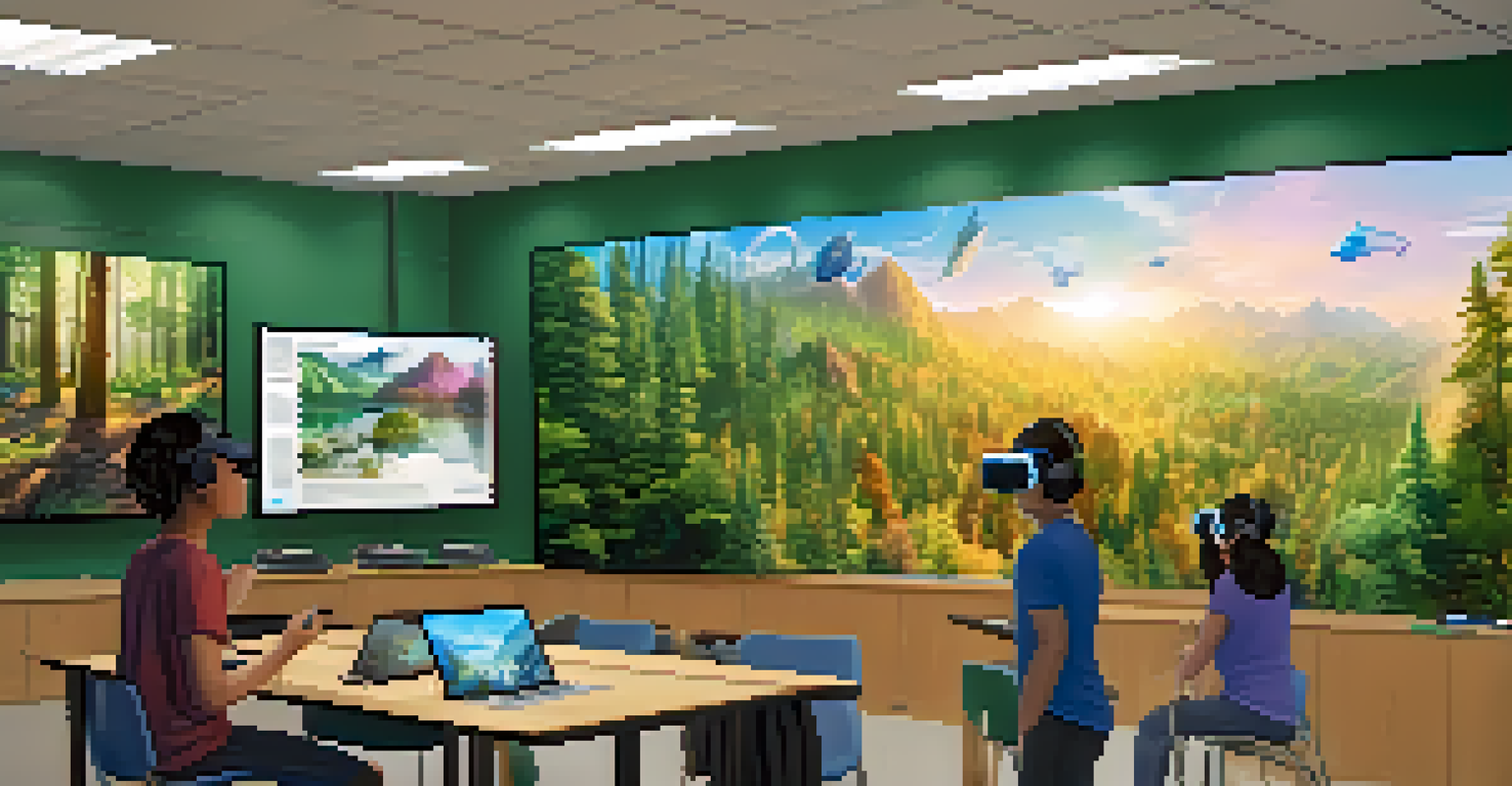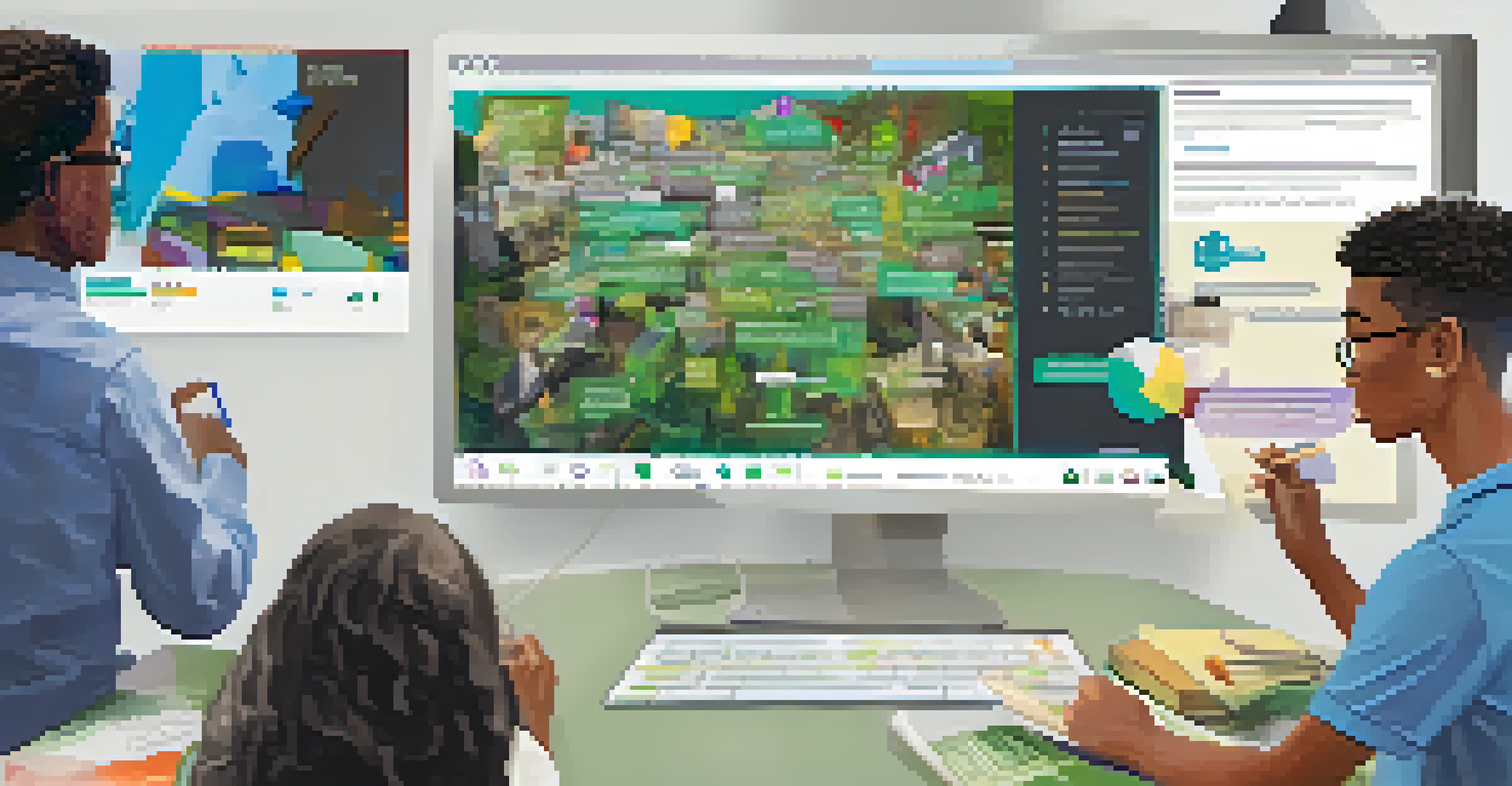Utilizing Digital Tools for Interdisciplinary Learning

Understanding Interdisciplinary Learning in Education
Interdisciplinary learning involves integrating knowledge from different subjects to create a more holistic understanding. For instance, a project might combine biology and art, where students create visual representations of ecological systems. This approach not only deepens comprehension but also fosters critical thinking and problem-solving skills.
The beautiful thing about learning is that no one can take it away from you.
By blending subjects, students can see real-world applications of their studies, making education more relevant and engaging. Imagine a history lesson that incorporates literature and science; students can better appreciate the context and impact of historical events. This synergy encourages a richer dialogue among disciplines.
Ultimately, interdisciplinary learning prepares students for the complexities of modern life, where problems rarely fit neatly into one category. It promotes adaptability and innovation, skills that are invaluable in today’s fast-paced world. With the right digital tools, these learning experiences can be enhanced and made even more impactful.
Digital Tools: A Catalyst for Interdisciplinary Learning
Digital tools have revolutionized the way we approach education, making interdisciplinary learning more accessible and engaging. Platforms like Google Classroom and Microsoft Teams facilitate collaboration among students and teachers, breaking down traditional classroom barriers. By using these tools, educators can easily share resources across various subjects.

Additionally, multimedia tools such as videos, podcasts, and interactive simulations allow learners to explore topics from multiple angles. For example, students can watch a documentary about climate change and then engage in a science project on renewable energy. These experiences not only enrich learning but also cater to different learning styles.
Interdisciplinary Learning Defined
Integrating knowledge from various subjects creates a holistic educational experience that enhances critical thinking.
Moreover, analytics and feedback tools help educators track student progress across disciplines, making it easier to tailor instruction to individual needs. By leveraging digital tools, teachers can identify strengths and weaknesses, ensuring that each student receives the support they need to thrive in an interdisciplinary environment.
Creating Collaborative Learning Environments Online
One of the significant benefits of digital tools is the ability to foster collaboration among students, even when they are miles apart. Online forums and collaborative documents enable students to work together on projects, encouraging them to share ideas and perspectives from different disciplines. This collaborative spirit mimics real-world scenarios, preparing students for teamwork in their future careers.
Education is not the filling of a pail, but the lighting of a fire.
Consider a project where students from different schools collaborate to tackle a community issue, such as waste management. Using digital tools like video conferencing and shared documents, they can brainstorm solutions, conduct research, and present their findings together. This engagement builds not only academic skills but also social and emotional competencies.
Ultimately, creating a collaborative online learning environment allows students to engage with their peers in meaningful ways. It cultivates a sense of community and encourages diverse viewpoints, which are essential for interdisciplinary learning.
Engaging Students with Interactive Learning Tools
Interactive learning tools, such as Kahoot! and Nearpod, bring an element of fun to interdisciplinary education. These platforms allow educators to create quizzes and interactive lessons that span multiple subjects, keeping students engaged and motivated. When learning becomes enjoyable, students are more likely to retain information and develop a genuine interest in the topics at hand.
Imagine a science lesson about the human body that incorporates a quiz game on anatomy. Students can compete in teams, reinforcing their knowledge while enjoying the process. This gamified approach makes learning feel less like a chore and more like an adventure.
Digital Tools Enhance Collaboration
Platforms like Google Classroom facilitate collaboration and resource sharing, making interdisciplinary projects more engaging.
By using interactive tools, educators can cater to various learning preferences, ensuring that all students can participate and succeed in interdisciplinary projects. This adaptability is crucial in creating an inclusive educational environment where every learner can thrive.
Personalizing Learning Experiences with Technology
Digital tools allow educators to personalize learning experiences for each student, accommodating their unique needs and interests. With platforms like Edmodo and Seesaw, teachers can assign differentiated tasks that align with students' strengths and weaknesses. This customization fosters a deeper understanding of interdisciplinary concepts as students engage with material that resonates with them personally.
For example, a student interested in environmental science might choose to explore the economic impacts of climate change, while another might focus on the social implications. By allowing students to choose their paths, educators can keep them invested in their learning.
Personalized learning not only enhances engagement but also helps students take ownership of their education. When learners feel empowered to pursue their interests, they are more likely to develop a lifelong love for learning, especially in interdisciplinary contexts.
Challenges of Integrating Digital Tools in Education
While digital tools offer numerous benefits, integrating them into interdisciplinary learning is not without its challenges. One significant hurdle is ensuring that all students have access to technology, as disparities can create inequities in learning opportunities. Schools must address these gaps to provide a level playing field for all learners.
Another challenge is training educators to effectively use these tools in their teaching. Professional development programs are essential for equipping teachers with the skills they need to integrate technology seamlessly into their curricula. Without proper training, the potential of digital tools may go untapped.
Personalized Learning Through Tech
Digital tools allow educators to tailor learning experiences to individual student needs, fostering deeper engagement.
Finally, it's crucial to strike a balance between technology use and traditional teaching methods. While digital tools can enhance learning, they should not replace the invaluable face-to-face interactions that occur in a classroom setting. Finding this balance is key to creating a well-rounded educational experience.
The Future of Interdisciplinary Learning with Digital Tools
As technology continues to evolve, the future of interdisciplinary learning looks promising. Innovations such as virtual reality (VR) and artificial intelligence (AI) are set to transform how students engage with various subjects. Imagine being able to explore the depths of the ocean or the surface of Mars without leaving the classroom—these tools can make such experiences possible.
Furthermore, the increasing focus on skills like creativity, collaboration, and critical thinking in education aligns perfectly with interdisciplinary learning. Digital tools can facilitate project-based learning, where students tackle real-world problems by drawing on knowledge from multiple disciplines, preparing them for future challenges.

In conclusion, the integration of digital tools into interdisciplinary learning not only enhances educational experiences but also equips students with the skills they need for a complex world. As we embrace these innovations, the possibilities for enriched, engaging, and meaningful learning are endless.